Sonic Adventures (Act 10)
The release of Sonic The Hedgehog [2006] was backed by the obligatory handheld tie-in, which on this occasion had come about through an indirect route. Sonic Team USA loosely supervised the creation of Sonic Rivals for the PSP, with most of the work being done by Canadian outfit Backbone Entertainment. The game presented the 3D modeling of the classic 2D gameplay which the gaming media had been demanding for so long, but with a twist. The levels served as racetracks, with the player character only clearing the stage if he was able to beat his opponent to the goal. In what marked an ongoing trend for the portable games, the title’s plot saw an attack on Sonic’s reality by Eggman Nega, with Robotnik’s counterpart apparently capable of the sort of evil which his conventional persona was no longer allowed to practise. The dire nature of the situation resulted in the ‘every hog for himself’ gameplay and an appearance by Silver indicated that Sega had genuine hopes for the character, before he was declared D.O.A. as a result of the shambolic game mode he fronted in his debut appearance. Rivals itself met with little enthusiasm, with the race mechanic regarded as an unnecessary complication rather than a novel feature.
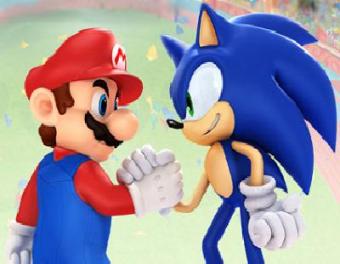 |
Sega’s growing links with Nintendo resulted in the announcement in 2007 of a formal collaboration between the two companies, for the long-awaited Sonic and Mario crossover. The title came in a different form than expected, however, with the Wii and DS game consisting of a set of minigames based about the Olympics license. As holder of the rights to titles based on the games, Sega developed the release, and publishing duties were shared between the two companies. The firms felt that the use of their most iconic characters would broaden the appeal to children of an Olympic release, and agreed that the formalised competition was a fitting banner under which to unite their mascots. Although the game has no plot as such, the choice of player characters drew extensively from both series’ canons, with other figures making cameos as linesmen, etc. Mario & Sonic at the Olympic Games was a massive commercial success, with the predicable winter sports sequel being scheduled for release during October this year. Also on the DS in 2007 was Sonic Rush Adventure, developed by Dimps as a follow-up to their original DS title. In a change of pace, this game pitted Sonic against a group of pirates, with Robotnik only entering the fray during the latter part of the game. At this point, it’s revealed that Sonic & Tails have accidentally entered Blaze’s dimension, with the mad scientist and his “Nega” counterpart having teamed up in a bid to destroy Blaze’s world. Despite some feeling that the level design had improved since the original Rush, the game’s positive ‘casual’ reception was not repeated, due to the need to repeatedly play mini games in order to acquire the ship parts needed to access the main action stages. A second ‘Rivals’ game from the original team at Backbone also appeared on the PSP during this year, with just as lukewarm a response as the first effort. At this point, development of 2D Sonic games branched out into the new area of mobile phones, with the vertically-orientated Sonic Jump eventually followed by an iphone version of Sonic Unleashed in early 2009.
Despite the promotional emphasis on Sonic The Hedgehog [2006], it wasn’t the only title that Sega was developing for a home console at this point. The progress made on the Wii title, however, was even more erratic than the fate of the next generation game. Spending much of its time in development under the name Sonic Wildfire, the brief was originally to simply find a way of making the hedgehog work with motion sensitive controls, as a stopgap before Sonic [2006] could be ported to the system. Given that title’s troubled development, however, the game that became Sonic and the Secret Rings was given the responsibility of carrying the icon’s torch for the system alone, being reworked to include an Arabian Nights theme. The plot is actually constructed quite intelligently, with Sonic being sucked into a book one evening when dozing by the fire. (It’s not clear if this is a literal description or whether he’s just dropped off the sleep.) Inside the world of the book, he’s drawn into a power struggle between two genies, being forced to locate the Secret Rings that control the book’s reality. In a neat twist, because Sonic was the last person to read the book, many of its characters appear as he’d imagined them, based on his friends and enemies. The Japanese team do quite a good job of eking out a satisfactory number of semi-original level concepts from the scenario, with only brief excursions involving pirates and dinosaurs breaking the setting somewhat.
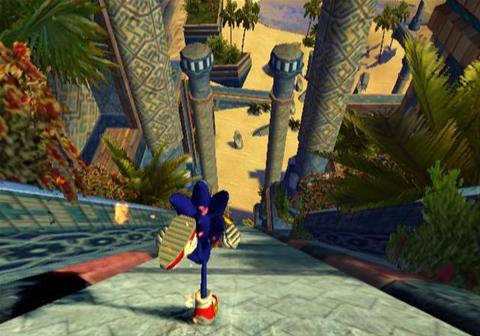 |
Regrettably, the gameplay undoes all of this work, with the utterly perverse implementation of the Wii’s controls sapping all entertainment from the game. While the game was initially described as playing like the sublime touchscreen sections of Sonic Rush, a wrong turn must have been taken somewhere in development, with the finished title alternating between bland sprinting and over-complicated combat. The fact that jumping attacks must be charged up means that the second half of the game is reliant on rote learning of the levels. Having to jolt the remote to perform a homing attack makes timing offensives unnecessarily difficult, and the fact that the ‘skill rings’ mean that Sonic only intermittedly has access to abilities which should have been unlocked from the start adds insult to injury. Despite being utterly terrible, the game sold strongly, and was soon being described as the first in a ‘Sonic Storybook’ sub-series, which would place the hedgehog in literature-inspired settings.
 |
As an aside, there’s a striking piece of iconoclasm in Secret Rings’ design, with the power-up structure that had been maintained since the first Mega Drive title being discarded in favour of pickups more suited to the gameplay. Most noticeably, the multi-ring pickups are simply a sigle ring with a number in front of it, instead of the usual smashable monitors. This move was arguably overdue, with Sonic ‘06’s adherence to the classic item boxes being arguably unnecessary. The invincibility pickup in particular was virtually useless, serving only as an opportunity to listen to the excellent riff of 06’s main theme. In this respect, Secret Rings was a trendsetter, with the next core game, Sonic Unleashed, abandoning all power ups save for rings and extra lives. The other bold decision made was to promote Kenichi Tokoi to lead composer for the game. This gamble paid off, with Tokoi providing a superb score, with the track for the last level a particular highlight, binding the somewhat loose concept together. Given the possibilities of a core game, he might one day be able to challenge Seoune for his crown.
After 2007, the next year proved to be extremely busy for Sonic, with one ‘proper’ title being supported by another DS game and the release of a Jun Seoune-produced compilation of music from the entirety of Sonic’s existence, entitled ‘True Blue’. The basic rule was that if it had vocals, then it made the cut, and songs were drawn from sources as diverse as Sonic CD and Sonic Rush Adventure. Given that most fans would have bought these pieces once already, the real lure was the bonus tracks, which included Seoune’s re-recorded Angel Island theme and a Lee Botherton remix of ‘Open Your Heart’. In a move calculated to confuse most buyers of the disc, the fan-favorite remixer, who had already contributed tracks to Shadow The Hedgehog was listed under the name Bentley Jones, an identity he’d created for his career in “proper” music.
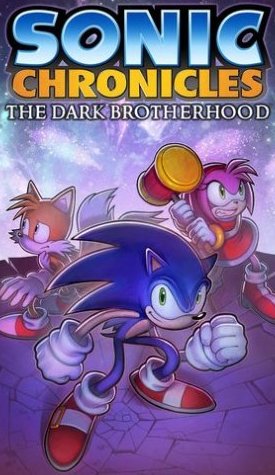 |
The first game released that year was Sonic Chronicles: The Dark Brotherhood. Fans had been advocating a Sonic RPG for several years, but the main appeal of the title was that it was being developed by Bioware, creators of Baulder’s Gate, KOTOR and Mass Effect. Before release, comments from the developers sounded extremely interesting. Interviews suggested that the game would serve as a means of tying up loose plot threads from throughout the series, while repositioning Robotnik as the main villain, a status undermined by his repeated duping at the hands of villains-of-the-month such as Perfect Chaos and Shadow. The icing on the cake was the announcement that Richard Jacques would return to the series in order to handle the music. (Jacques also provided the score for Sonic’s non-canonical headlining of sports title Sega Superstars Tennis.) The game itself was a massive disappointment, however, with the perfunctory RPG gameplay only the start of its problems. The art direction was extremely curious, with the look adopted neither replicating the traditional style of Sonic titles nor of high enough quality to justify the departure. It’s all very well naming the first level “Green Hill Zone”, but if it doesn’t even slightly resemble the previous incarnation of the level, then there’s very little point. The plot was also uninspired, with an initially interesting story about the emergence of a lost tribe of echidnas being quickly discarded. The cast soon found themselves warped to an alien planet, home to a hive-mind enemy far more clearly within Bioware’s usual comfort zone. Either the developer’s heart was never in the title or their purchase by EA during its development had been a severe distraction.
What followed this disappointment was the last thing anyone expected, however. The big-budget multi-format blockbuster Sonic Unleashed had been dogged by controversy throughout its short two-year development period, but the final product was utterly magnificent, providing the strategic rethink of the series that the more powerful hardware merited. A new mechanic was implemented for Sonic’s movement based around the abilities of his cartoon incarnations, with the inclusion of the ring-powered ‘boost’ function that had dulled Sonic Rush proving a much more workable proposition in 3D. The result combined with the extended range of the homing attack and greater momentum of the character to produce a mechanic that enables the sort of stunts that the hedgehog could previously only produce in one of his non-playable forms. The pooling of resources from the differing arms of Sega had obviously had a beneficial effect on development, with the game remarkably solid. The new Team was also able to square the circle of the need to include a second playable character to extend the length of the game and casual players’ desire not to control anyone other than Sonic, by introducing an alternate “Werehog” form for the character.
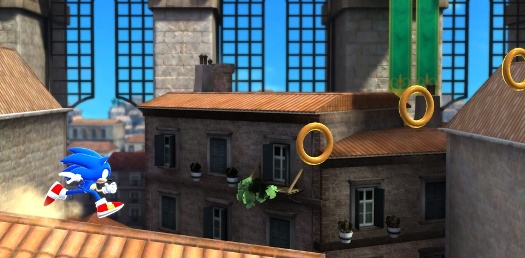 |
The plot continued from the scenario of Sonic Adventure and Sonic [2006], with Robotnik attempting to utilise another elemental, this time an earth-based monster, before it inevitably turns against him. Sonic was accompanied by a slimmed-down cast of followers, with just Tails and Amy joining him in attempting to fix the shattered globe using the Chaos Emeralds and reverse the mutagenic effect of the Dark Gaia monster on the planet’s inhabitants. The simple story is plotted in detail, with an overall message of balance and cycles, as Sonic discovers that his amnesic ally Chip is actually a being that is destined to defeat Dark Gaia every time it awakes. In many ways the game provided a conclusion to the emphasis on real-world locations as the inspiration for the latest “Sonic Holiday”, with the hedgehog touring many spots on the globe. I could talk about the game all day, but to save repeating myself, the article I wrote for this website earlier in the year can be found here.
Sonic Unleashed would have been a nice highpoint on which to end this series of articles, but being a Sonic fan means you have to take the rough with the smooth, not least of which was Unleashed director Yoshihisa Hashimoto leaving Sega to seek his fortune at Square Enix on completing the game. Since I began putting together ‘Adventures’ at the start of the year, we’ve seen the release of the second ‘Sonic Storybook’ title, with the hedgehog this time finding himself sucked into Arthurian legend in Sonic and the Black Knight. The title has achieved the unusual feat of being slated by both critics and fans, with the superb presentation of the title not compensating for a simplifying of the already basic levels of Sonic and the Secret rings. The one bright spot is the return of Jun Senoue to the series, leading a bank of composers including Richard Jacques and NiGHTS maestro Naofumi Hataya. While it’s a pity that he couldn’t have devoted his talents to the vastly superior Unleashed, the break has obviously refreshed the composer creatively, and both the vocals and in-game music CD releases are essential purchases. The letdown of the Black Knight means that fans’ hopes are currently centered on the next Superstars game, a racing title by Sumo with a stronger Sonic focus. Despite balancing issues related to the size of characters forcing the hedgehog to participate in a car rather than on foot, the latest from Sheffield’s finest should provide plenty of entertainment on its release next year.
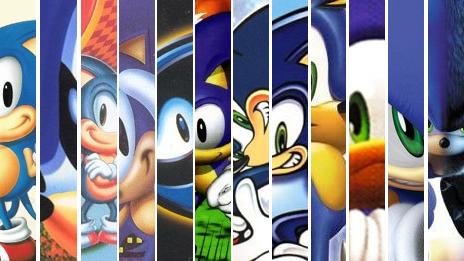 |
I’ve been wrestling with the issue of how to end this series of articles for some time now. A final attempt to define what makes the character so appealing? A reminder that the world’s largest Sonic convention hits London at the end of this month? The fact that the Mega Drive era of the early nineties and the Sonic X marketing blitz of the start of this decade suggests that we’re only a couple of years away from another burst of mainstream popularity being due?
Nah.
We’re going to end with something I only noticed the other night, while trying out the PC version of Sonic Adventure. We’re going to end with the fact that if you run through the patches of dandelions found in the Windy Valley Zone, then clumps of seeds are released into the breeze.
And if you’re surprised by the fact that spotting a forgotten detail in an eleven-year-old video game made me smile, then you really haven’t been paying attention.
About this entry
- By Julian Hazeldine
- Posted on Sunday, August 16 2009 @ 7:21 pm
- Categorised in Games, Analysis
- Tagged with sonic the hedgehog, Sonic Adventures, Sega
- 5 comments

This was great, Julian. I’m looking forward to the Resident Evil series that I’ve convinced myself you’re doing next.
By Phil
August 17, 2009 @ 1:38 pm
reply / #
A most excellent series of articles. I feel enrichened and just a little bit closer to wanting to play a 3D Sonic title without wanting to vomit everywhere.
By Jonathan Capps
August 17, 2009 @ 7:42 pm
reply / #
A very good series of articles indeed. Bravo, you have simultaneously made me nostalgic and sad that nothing has really touched the greatness of Sonic 3 & Knuckles. (I’m sure had I played Sonic Adventure 1 and 2 on Dreamcast when they originally came out as opposed to on GC on clearance, that would’ve been the standard of excellence). As you mentioned, all of the 3D games had glimmers of greatness, but all had some glaring deficiency.
I have to disagree with you however regarding Unleashed (on wii) and Secret Rings. Graphically, SR seemed superior going for a more stylized, smooth toony look rather than the realism of the grainy Unleashed. And while the motion controls weren’t perfect, especially when coupled with the slow level-up system, I felt more in control of, and enjoyed the running sections more than Unleashed which largely played itself with few enemies except to open up diverging paths. Gaining new abilities also made the game refreshing whereas Unleashed was a straight race to the finish. And don’t let me get started on the werehog sections…
Just wondering where you stand on the following debate. People often argue Sonic is about speed and to go back to the franchise’s roots developers need to focus on speed. I wholeheartedly disagree with that— but at this point, there is no core 3D sonic game play. What do you think should be the focus of the 3D games? Should it be comprised of speed like Secret Rings and half of Unleashed, or more platforming such as Adventure and StH 2006? Or something more neutral like Sonic Heroes?
Again, great job on the series.
By Aus
August 18, 2009 @ 10:37 pm
reply / #
The great thing about 2D era Sonic is that you could speed through or take your time and the game would be rewarding and fun. There should always be room for both styles in any Sonic game, and from the little I’ve seen of unleashed they’ve at least tried to address this by presenting the two extremes as different game modes. Can’t imagine being a perfect solution, though.
By Jonathan Capps
August 19, 2009 @ 5:42 pm
reply / #
Aus
Thanks for the kind words! I regard the core 3D Sonic gameplay as being that established in the two Adventure games, and horribly botched in ‘06. It’s a mixture of fast placed levels and slower sections, with a strong reliance on the magnificently satisfying homing attack. The original Sonic Adventure got this spot on, and I always point to Speed Highway as being the perfect example of variety in gameplay. There’s a fast paced rooftop section, followed by the bonus game of running down the skyscraper and then a calmer, more exploratory closing act with Sonic at street level.
Unfortunately, I still can’t reconcile myself to ‘Secret Rings. The challenge in the levels came from the broken controls, with the need to charge up the jump meaning that you had to learn by rote the later stages to pass them. I can’t find anything nice to say about the leveling up: one of the equipable modes gave Sonic smoother handling for turns, effectively making “better controls” an unlockable feature. The art direction has its moments, but Shadow aside, there isn’t a single main series Sonic title that doesn’t look nice, and it’s comprehensively outdone by last year’s effort. ‘Realistic’ Unleashed may be, but it’s far from grainy. The idealized settings are utterly beautiful, particularly Greece, Italy and Hawaii…
By Julian Hazeldine
August 19, 2009 @ 7:50 pm
reply / #